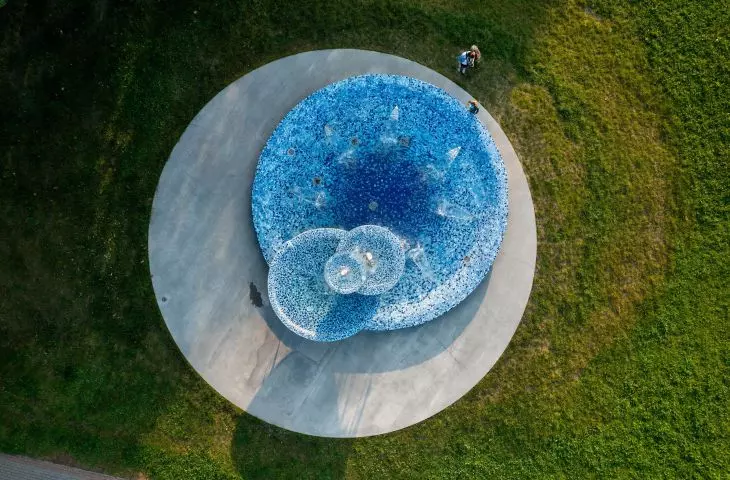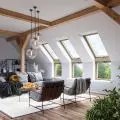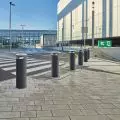The fountain in Tychy 's Niedźwiadków Park has undergone a painstaking process of reconstruction, as well as transformations developed by Paradox Architectural Studio. How has this iconic place frequented by Tyszans changed?
Certain places in the collective memory of city residents are so important that their elimination is not an option. The fountain in Bear Park is one such example, so it could not disappear from the map of the city, although over the years there has been far-reaching degradation.
Szymon Borczyk of Paradox Architectural Studio talks about how to work on projects with such a high level of nostalgia, the problems of preserving ceramics from the communist period, and how far the fountain's shape and substance were interfered with.
Wiktor Bochenek: The fountain in Niedźwiadków Park next to the famous "Giraffe" is an iconic place for Tyszans. Was the revitalization of this object a challenge for you?
Szymon Borczyk: The fountain has definitely established itself as one of the most distinctive elements of Niedźwiadków Park, I don't know if not even more than the bears themselves. The reason for this may be its prominent location, well visible from the road, as well as its very nature. Objects of this type, after all, on hot days allow you to cool down, and on other days of the year simply enjoy their appearance, illumination.
Tychy fountain after restoration
© PARADOX Architectural Studio
When we undertook the project to revitalize such a well-known landmark in Tychy, we were convinced that this, admittedly small project, would be quite a challenge for us. We were aware that our work must be primarily about enhancing its quality, not improving it, because the form of the fountain has perfectly balanced proportions and a fantastic composition. Its only shortcomings were the poor quality of the materials used for it, and over time also only ad hoc repairs and unfortunate decisions to repaint it in such an intense blue color, which was done a couple of times.
Tychy fountain after restoration
© PARADOX Architectural Studio
This color, by the way, eventually also became its distinguishing feature, which we were well aware of. So, during the design process we faced a dilemma: rigidly stick to the design guidelines and the original color of the fountain, which was finished in raw concrete, or lean towards the expectations and habits of the residents? In the end, the best way turned out to be simply a compromise, and we decided to refer to both color variants at the same time, so the fountain bowls on the outside are finished in shades of gray, while on the inside they are blue.
A separate issue was the choice of the type and shape of the mosaic itself. We spent a lot of time studying Polish and world realizations, as well as revitalizations, where this type of cladding was found. We did not have to look far for some outstanding examples, after all, Tychy is dotted with extraordinary works, such as the mosaic on the western facade of the Little Theater building, at Primary School No. 18 on Fitelberga Street, or at School Complex No. 4. This one used to be at the entrance to the building of the now-defunct Mining Electronics Plant.
Ms. Bozena Kostuch 's comprehensive book "Color and Brilliance" on architectural ceramics and mosaics in Cracow and Malopolska after 1945 was also very helpful and inspiring. One of the almost identical examples of revitalization is the 1974 fountain in Kosciuszko Square in Gdynia, which in this case was clad with a mosaic cladding of hand-formed glass. All these realizations we have learned about and a closer look at the history of mosaics in the context of Tychy in particular have reassured us that hand-laid, broken ceramic tiles would be the most suitable material in the context of the history of mosaics, as well as the city itself.
Tychy fountain after restoration
© PARADOX Architectural Studio
Cooperation with the people arranging the mosaic itself also proved very fruitful, including Marlena Jędrocha, who, with her vast experience and understanding of the subject matter, immediately understood the assumptions of the project and was also able to make her personal artistic contribution to it.
Wiktor: How did the immediate surroundings of the fountain change?
Simon: The fountain was originally surrounded only by a grassy area, which, due to the great popularity of the object, degraded very quickly. Over the years, a ring of questionable quality rectangular concrete cubes appeared around the lower bowl. A large rectangular cracked concrete cover for the technical room also stood out in the pavement. We wanted to expose only the fountain, so we opted for a simple and smooth concrete slab that protects the area around the bowls while covering the pump and filter room. We cut the slab with a free composition of expansion joints, referring to the shapes of the mosaic tiles.
The fountain in Tychy after restoration
© PARADOX Architectural Studio
Wiktor: What has changed in the fountain itself?
Szymon: The simplest thing to say is that everything. The only original elements are the two lower bowls. We had to dismantle the two uppermost ones due to their technical condition, as well as the need for new water supply and lighting installations.
Originally, we were very keen to keep all the bowls original, but unfortunately, the size and condition of the tallest ones completely ruled out the possibility of introducing installations into them. The only sensible option was to restore them, and they were accurately reproduced as prefabricated pieces with all the necessary fittings installed in them.
laying mosaic
© PARADOX Architectural Studio
The way the water flows is also a major change, we lowered the banks of the upper bowls piecemeal so that the water cascades down to the lowest one. The original solution was runoff through holes in the bottoms of the various sections, but due to the site' s location, the solution was a major failure. Tree leaves notoriously clogged the small nozzles. The fountain was also upgraded with new nozzles, technological equipment and lighting.
Wiktor: Towhat extent is this a restoration of the facility, and to what extent a creation?
Simon: Despite the fact that at first glance the fountain has almost completely changed its face, we think of the facility in the context of a restoration. Particular attention in this evaluation should be paid to leaving its most important qualities, namely proportions and composition. You can see the mosaic and the way the water runoff is shaped, as well as the lighting with later elements, noticeable on closer contact with the object.
Victor: Thank you for the interview!
remodeling process
© PARADOX Architectural Studio

































